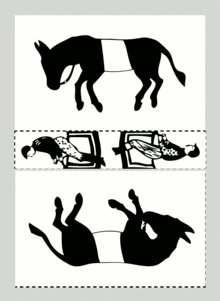
Famous Trick Donkeys is a puzzle invented by Sam Loyd in 1858,[1] first printed on a card supposed to promote P.T. Barnum's circus. At that time, the puzzle was first called "P.T. Barnum's trick mules".[2] Millions of cards were sold, with an estimated income for Sam Loyd of $10,000 from 1871[3]—about $200,000 in 2014 dollars.[4]
History
.jpg.webp)
(Nr. 14.629 in the Museum of Fine Arts, Boston.)
According to Martin Gardner, the puzzle may have been inspired by a 17th century Persian design, currently in the Museum of Fine Arts, Boston.[5] (It was purchased by the museum in 1914 from Victor Goloubew. The latter acquired it in 1912 and exhibited it in Paris.[6])
In 1858, Sam Loyd says he thought of a puzzle card that consisted on two mules and two riders. Dividing the card into three pieces the player had to place the cards in a way that each mule had one rider on. In 1871 after he had published The Wonderful Chinese Pony Puzzle, Sam decided to publish his mules puzzle renaming it the "Puzzle of the Trick Mules".
P. T. Barnum saw the opportunity to promote his show on this puzzle card and offered ten thousand dollars to Sam Loyd to change the name of the puzzle to "P.T. Barnum's Trick Mules"[7] Later on, and after Loyd had offered the puzzle to other firms, it was renamed again to "Famous Trick Donkeys", which sold more than 100,000,000 copies.[8] Today The Sam Loyd Company owns the rights to the puzzle and released a commemorative puzzle card in 2016, 145 years after it was first published.[9]
Puzzle
The printed card of the puzzle shows two donkeys, the central part of which has been left blank on purpose. The third part of the card are the riders, and the objective of the puzzle is to arrange the three pieces (the two donkeys and the riders) so the riders are mounted on the donkeys' backs.
Variations
In the 1857 version of the book The Magician's Own Book or the Whole Art of Conjuring there appears a picture of two dogs lying on the ground facing opposite sides. Called "The Dead Dog Puzzle" the objective was to draw 2 lines which make the dogs seem to be alive, instead of lying on the ground. In 1939 another variation of the puzzle was found as a prize of a popcorn company in their packages, the puzzle showed two mules and two cowboys. This time the mechanics of the game were the same as Sam Loyd's, other companies used a tiny card with this puzzle as a gift, like the Hotel Wellington in Albany in the 50s.
_14_224_2_Zeichenaufgabe.PNG.webp) "The Dead Dog Puzzle"
"The Dead Dog Puzzle"_15_240_3_Die_Aufl%C3%B6sung_der_Zeichnenaufgabe_No_1.PNG.webp) "The Dead Dog Puzzle" solution
"The Dead Dog Puzzle" solution
Today, many puzzle and mind-teasers websites offer the puzzle as an online game or a print-friendly version of it.[10]
Solution

The solution for the puzzle is that of the two horses drawn the head and back of each is not the one linked with lines. The head for the first horse is the back of the horse on the other side of the card and vice versa. To solve the puzzle the two horse pieces are placed in a way that the back of the horse on the first piece is facing the back of the horse on the second piece. In the gap between should be slid the jockey's piece of paper, thus forming an image on which a horse is running to the left and the other to the right, one upside up, and the other upside down.[11]
References
- ↑ "Trick Donkeys Puzzle". The Worlds of David Darling. Retrieved 19 March 2015.
- ↑ "The famous trick donkeys: a Sam Loyd puzzle". Division by Zero. Retrieved 19 March 2015.
- ↑ "Sam Loyd's Trick Mules". Defective Yeti. Retrieved 19 March 2015.
- ↑ "Inflation calculator". Dave Manuel. Retrieved 19 March 2015.
- ↑ Gardner, Martin (1959). "Chapter 9: Sam Loyd: America's Greatest Puzzlist". Mathematical puzzles & diversions. New York, N.Y.: Simon and Schuster. p. 95.
- ↑ "Four Interlaced Horses". Museum of Fine Arts, Boston.
- ↑ "Cracker Jack Cowboy Puzzle". Bc.ca. Archived from the original on 9 October 2014. Retrieved 19 March 2015.
- ↑ "Sam Loyd, Puzzle Man, Dies" (PDF). The New York Times. April 12, 1911. Retrieved 19 March 2015.
- ↑ "145th year commemorative puzzle". Sam Loyd. Archived from the original on 19 March 2015. Retrieved 19 March 2015.
- ↑ "Two deceptive 19th Century puzzles: The Trick Mule Puzzle, and The Dead Dog Puzzle". Deceptology. Retrieved 19 March 2015.
- ↑ "Sam Loyd's Tricky Donkey" (PDF). amagicclassroom.com/. Retrieved 19 March 2015.